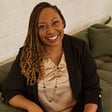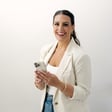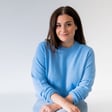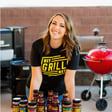Become a Creator today!Start creating today - Share your story with the world!
Start for free
00:00:00
00:00:01

Episode 150: How To Start and Grow a YouTube Channel in 2022
Trena Little, YouTube strategist and creator of the Video Strategy Academy, joins me on the podcast today to chat about how to start and grow your YouTube channel. Trena and her team helped us jumpstart our YouTube channel over last year and we're happy with the results. They know what they're doing so we're excited to share the episode with you. If you're interested in growing your channel, be sure to check out her Video Strategy Academy which opens back up in May of 2022.
For show notes visit...https://daveyandkrista.com/start-grow-youtube-channel-2022/
Transcript
Engage Audience with Specific Prompts
00:00:05
Speaker
I like to, when I do my video game plan, I like to then review it again and see, okay, where can I put some piece of engagement that makes sense? And so if I'm talking about a content plan, I'll be like, you know, hit that like button if you've ever stressed out on what to post and you've posted the day it needs to go live.
00:00:22
Speaker
And so that makes them like, oh yes, that's totally me. Hit that like button. Instead of just saying, hit the like button if you like this video, give them like an enticing reason to do it. And the same with the comments. Sometimes you maybe just say, you know, are you stressed over content? Like put stressed out in the comments below so I know you feel me on this one. And so that can get you more engagement when it's more specific and it gives them a reason to wanna engage with you.
Introduction to Trina Little and YouTube Growth
00:00:49
Speaker
Welcome to the Brands at Book Show, where we help creative, service-based businesses build their brands and find more clients. I'm your host, Davy Jones.
00:00:58
Speaker
Trina Little, YouTube strategist and creator of the Video Strategy Academy joins me on the podcast today to chat about how to start and grow your YouTube channel. Trina and her team have helped us jumpstart our YouTube channel over the last year, and we're really happy with the results. They know what they're doing. So I'm really excited to share this episode with you. If you're interested in growing your channel, be sure to check out her Video Strategy Academy,
00:01:23
Speaker
which opens back up in May of 2022. One other quick announcement, our spring line of website designs has launched, including two new full website designs and I think what might end up becoming our most popular add-on page, the Family Portrait Guide. You can see all the new releases at dvandchrista.com forward slash shop.
00:01:46
Speaker
And be sure to check out the show notes at davianchrista.com for the resources that we mentioned during the episode, and we want to hear from you. Let us know what kind of content you'd like to see on the Brands Up Book podcast as we move forward. To leave your feedback, just send us a DM on Instagram, at Davian Christa. Now, on to the episode.
Procrastination to Consistency in YouTube Efforts
00:02:07
Speaker
All right, so we should be live. So for everybody tuning in on iTunes, as this is loaded as a podcast, trying a bunch of new things today, so something's bound to come up. So hopefully we don't have any issues. But I'm really excited to be back with Trina Little. Trina's been on the podcast before.
00:02:26
Speaker
where she's chatted about YouTube. And back then, as everybody knows, I was like, I really got to get into this YouTube thing. Fast forward years later, literally years later, and we asked Trina's team to step in and actually help us get started because it was obviously something that I kept on saying I was going to do and never did. And so I needed somebody to hold us, especially me, accountable. So Trina's team came in and helped us. And since then, we've released a video just about every week for, I don't know, the last six months plus.
00:02:56
Speaker
Yeah, at least six months. Last summer-ish, maybe? Yeah, it's been a good experience on all sorts of levels. One, Trina's team has been awesome to work with. Two, I think it has just made us more comfortable with video in general. So it's not this big, scary thing anymore.
Video's Rising Importance for Trust and Traffic
00:03:12
Speaker
Video has become so much more important, I think, in the last
00:03:16
Speaker
Certainly in the last year or two, it's become important over, you know, longer than that for sure. But it's just such an easy way to build trust quickly. So I'm excited to kind of revisit our conversation that we had a few years ago, talk a little bit about how to get started with YouTube, how to do that effectively in 2022 and beyond. And also, I'd love to hear some of your experience working with our channel and some things that went well. And so I'd love to hear all about that. But anyways, could you fill us in? What have you been doing for the last couple of years?
00:03:46
Speaker
Just a few years of time to fill us in. Just a few years, you know, I mean, there was that whole thing that happened in 2020. And yeah, so I've basically just been focusing on YouTube, like consistently YouTube video every single week, because as we know, school and daycare was all up in the air in the past couple of years. And we'll do small kids. I just had to do the bare minimum that I could do.
00:04:09
Speaker
And for me, that was a YouTube video every week because that helped me create email content and social media content. So I really just kind of focused on that. And then because of 2020, we kind of scaled our agency not planning to, but a lot of people were in the same situation as me, where they were limited on time, they knew they needed video, they just needed someone to do it. And so we grew our agency by like
00:04:35
Speaker
300% from 2020 to 2021. And so it's been really fun. It kind of tips the ladder on what you're working on. So for a lot of my business career, entrepreneur career, we've been focusing on our programs and our courses and our digital products. And then the past year and a half, it's just really been heavily skewed towards the agency.
00:04:57
Speaker
Creating processes systems employees and so it's kind of where my heads really been the same focus with a youtube video every week to continue to drive traffic cuz in addition to twenty twenty there was also the facebook ads blow up of twenty twenty one.
00:05:12
Speaker
And so people were also looking for other ways to get traffic and not have it all on the Facebook ads bucket. And so it's been a lot. It's been a lot the past two years. I thought I would be slowing down around now and it just seems to get busier.
00:05:27
Speaker
Yeah. And all that makes so much sense.
Updating YouTube Strategies with New Data
00:05:30
Speaker
I can totally see why your agents would be growing, not only with the general landscape, but then also just because you all do such a really good job. You do a really good job of communication and staying on top of clients. So that's been just a really positive experience coming from somebody who has worked with you.
00:05:46
Speaker
But then, you know, the Facebook ad blow up, you know, as somebody who runs a advertising agency, we've never, you know, it's the silver lining, though, to your point was that we have so many clients now advertising on other platforms than Facebook. And so for years, we've been saying, you know, what if you tried out Google? What if you tried out Pinterest? You know, Facebook, because of some of the changes, not necessarily because of Facebook, I guess more because Apple has forced people to explore different channels. So a little bit of a silver lining there, I guess, even though attribution reporting has been a nightmare. But
00:06:16
Speaker
We're not here to check out about that. But yeah, I want to dive into some of the YouTube stuff. I do want to mention at the outset here, you have your Video Strategy Academy, which already exists. It's closed right now, but it will reopen in May. So anybody listening to this is like, I need Trina's help with YouTube.
00:06:35
Speaker
You can check that out. That will be open again in May, but you can go to Trina's website, sign up for her email list, and I'm sure you'll be notified as to when that becomes available again. And the reason why I generally don't like to close and open doors because people want something, they want something now, but we're actually updating
YouTube as a Key Traffic Source
00:06:54
Speaker
it. So being in the agency the past year, working with so many clients, we've had so much data coming
00:06:59
Speaker
Because before, it's just kind of been my experience and working with clients and another client's agency because I work for another YouTube educator. And so it's just that's been the experience. And now we've really just blown the door open on so much data. And so we're taking everything that we learned over the past year and updating the program right now. And so I'm just really excited to get it out there, brand new stuff up to date, like 2022, great information.
00:07:25
Speaker
Yeah. And that's why I'm really excited about this conversation because you've worked with so many different people. And so the principles that you have in your video strategy Academy, for instance, you know, don't just work for you, you know, they work for other people as well. So maybe you could just, you know, this is sort of a softball question, but you know, basically, is YouTube still worth it in 2022? And I think I get the same, the same response when I start talking about podcasting, where it's like,
00:07:49
Speaker
Well, it seems like everybody has a podcast now, and I don't know, should I do it? And I don't really like the video thing. But make your case for YouTube. Yeah, so 100% is still worth it. And the one thing that's been really unique in the agency, because it's not something that I was focusing on in my prior background experience, because it was more YouTube hobbyist, people who wanted to become YouTubers. But in our agency the past year and a half, it's been 100% business owners.
00:08:16
Speaker
entrepreneurs just needing traffic to their offers, their one-on-one services. And so that's really opened our eyes to how to approach YouTube for business owners. But I definitely think it is because even within the past year and a half working with business owners, they come to us telling us, I'm getting traffic from YouTube. I log into my digital shop analytics and the number one traffic source is YouTube.
00:08:40
Speaker
And this is coming from a channel with less than 30,000 subscribers. And so that's still a valid traffic source, as opposed to Google. And even sometimes Facebook ads, depending on the budget people have for their Facebook ads, because YouTube lives there. And YouTube is available when they need you most. And if you can show up and search on Google or on YouTube, and they're like, wow, this is awesome.
00:09:04
Speaker
Not only are they going to be more likely to convert because they know you, but you can solve their solution right when they need it. And so that just makes such a huge asset. I like podcasting. I dabble with podcasting as well. I just can't find the searchability when it comes to podcasting. That alone has really been such a huge factor for so many of my clients that have come to the agency.
00:09:29
Speaker
Yeah, and that's one thing that really stands out to me. Podcasting episodes are definitely searchable. It's really nice. I really like the podcast for a number of reasons. Get to talk to great people like yourself. Also, it's great content that I can point people back to if I'm on the phone with somebody or whatnot. But from a searchability standpoint, it seems that YouTube has – I mean, and it is a Google property, right? But it just adds another level.
00:09:54
Speaker
or another area where you can be found online. So not only will your YouTube videos show up in search, but we embed YouTube videos in posts. That seems to have a positive impact on the post itself a lot of times. And doing it consistently, what we found is now we're starting to see more consistent inquiries come in from YouTube. I agree with, I think, everything you're saying. The other thing too is
Start with Imperfect Videos to Collect Data
00:10:17
Speaker
You know, so some of the videos that we did with you really early on, still week after week do well. Whereas like there's, or have grown in traffic. Whereas with the podcast, typically the older the episode gets, the less traffic you get from it. Whereas we have like some YouTube videos that, you know, we just kind of turn on the camera and did it just out of necessity because we were recording a video for a client. And again, they still get a ton of traffic or a ton of views week over week. And you just don't see that on the podcast.
00:10:46
Speaker
Yeah, that's such a huge asset. Even for me, I was doing some research. 2019, I have a video that still gets over, I think the last time I looked at my analytics, like 1200 views a month from 2019. And it's like my post on Instagram from 2019 is not even being looked at. So it's just for somebody who really wants to not be working on creating so much stinking content all the time. It just alleviates a lot of that hamster wheel of content creation.
00:11:16
Speaker
Yeah, awesome. Well, let's dive into it then for somebody who is convinced they need to get back into YouTube. Maybe they have a channel or it's and it's kind of fallen by the wayside or you know, they're starting from scratch. Can you kind of walk us through how you would instruct that person to get started?
00:11:34
Speaker
Yeah, so it's kind of funny. I've been talking a lot with brand new people jumping into YouTube with Video Strategy Academy. And it always seems like somebody is looking for this secret. What is this YouTube secret? And I just have to kind of nudge them and say, you have to get videos on YouTube. Because one of the main points in working with our clients, we do every single month is a report.
00:11:58
Speaker
because this gives us the data on exactly what we should be focusing on, what we shouldn't be focusing on, and what's going to work for us in the future. And so without any data on YouTube or any recent data on YouTube, it's kind of really hard to figure out what that strategy should be. It's like looking into a crystal ball, right? We can't see the future. And just getting test videos up on YouTube, like six to eight videos on YouTube, so you can start getting data, seeing where YouTube is kind of categorizing you, that's going to be a big
00:12:27
Speaker
first step. I know we have to just kind of get that perfectionism out of our head, that perfect equipment out of our head, and just create videos that you know your audience is asking for. I know you mentioned about you were sending people to podcast episodes when you get questions. Thinking about YouTube episodes is that as well. What are things that your audience is asking you that you can just start getting comfortable on video? So that's kind of like the first step is we just need to get some videos on YouTube.
00:12:54
Speaker
Sure. You didn't mention equipment, even though you said that people are still saying, but like, okay, what really, what equipment do I need? Is there a sort of bare minimum, you know, when it comes to equipment that you would recommend?
00:13:04
Speaker
Yeah, your cell phone. I've gotten to a pinch a couple times and I used to use this bigger camera, this Canon M50 with a couple hundred dollar lens. And when I would record, it was blurry and I get frustrated and I'm not going to redo it, whatever. I'm putting that video up blurry. And so tech started to be a struggle for me and it caused me not to like doing videos because I had to set it up. So for a while till I determine, you know, what am I going to do to solve this problem? I use my phone for multiple videos on my YouTube channel.
00:13:33
Speaker
I bought, the brand's called a Lume Cube and you can buy this creator kit that comes with a plug-in microphone with a little, you know, square LED light and a tripod. And it's literally for basically TikTok creators, I would say. But I used it for my YouTube videos and I used my cell phone and some of those videos for my cell phone have some of the best audience retention or one of the biggest growing
00:13:57
Speaker
videos on my channel. And so sometimes we forget that our cameras on our phone are great. And I just I like to minimize any kind of tech hurdles in my way.
00:14:07
Speaker
Yeah. And I think that's a really good reminder. I'd say for the podcast as well.
Authentic Content and Improving Click-Through Rates
00:14:11
Speaker
I mean, it took me a while to get to a mic like this, but some of my most listened to episodes were on my own, my old, I forget what they call it, Snowball or Snowflake, you know, the Blue Yeti or the Yeti. Yeah. And before that was the little Snowball mic also from that same company, Blue. But I had to learn that both for the YouTube channel and for the podcast where I went through this, well, I just need this mic and then things will
00:14:34
Speaker
Logically, that doesn't translate into subscribers or listens or whatnot, but I know it's a question that people are asking. Once you get content up on YouTube, what's the next step? What are you looking at of those six to eight videos that you have now up on YouTube? What sorts of things are you looking at to determine, okay, where do I go from here?
00:14:54
Speaker
So one of the things you want to be looking at is how well your videos are actually encouraging people to click on them. So some things that we look at is click-through rates. So how well our titles and our thumbnails are getting people to click, which is something. It's been a huge shift for a lot of business owners coming over to YouTube because they're so ingrained in SEO and Google SEO. And YouTube has really changed the way that they approach your behavior ship on YouTube.
00:15:20
Speaker
And you could literally have zero SEO words in your title and still show up for that particular topic because YouTube is basically listening to your video so it knows what your video is about when you upload it. And it's looking for other metrics like if they show this to people on their homepage or in suggested, are they actually going to click on it?
00:15:38
Speaker
And then audience retention. Are people watching to the end of this video? Are people, you know, liking it? Are people commenting on it? These are all positive factors. I like to think of YouTube as like Mario Brothers when you went down the green tube and you had to collect all these gold coins. Trying to hit all these gold coins on YouTube to make your channel look more valuable. Because if you do, YouTube's gonna do all the promoting for you. YouTube's gonna put you on the homepage of the right people. YouTube's gonna put you in suggested videos.
00:16:05
Speaker
I think it's really focusing on how can I pitch this video or market this video specifically for my audience and what would make them want to click on this video. As far as the video itself goes, is there a magic number when it comes to how long the video should be?
00:16:23
Speaker
probably get this question at least once a day. And there is no right or wrong answer. How we approach our content in my business and then in our agency is we think about, okay, what is the best title for this particular video that we can do? And then what is the content I need to have the follow up to promise on that title?
00:16:45
Speaker
that title is pitching something really good like clickable thumbnails in under 10 minutes. Obviously, that's got to be under 10 minutes. But if I'm like creating a YouTube strategy that drives more leads to your business, I need to make sure that video delivers on that title. And so however long it ends up being is kind of however long it ends up being. In fact, we were trying to figure out too, we've had some longer videos recently on our channel like the 20 to 30 minute mark and
00:17:12
Speaker
Prior to I've done shorter videos of 5 to 10 mark. We did a poll on our YouTube channel recently and it was almost split down the middle if they liked longer or shorter videos. So I just really focus on how much time do I need to deliver on the promise of the title and just really not adding any fluff just to hit a certain length. What about in terms again going back to the video itself, how produced the video has to be?
00:17:38
Speaker
Yeah, that goes back to just getting videos up on YouTube. I definitely don't recommend because I've gotten this question quite a lot this week speaking to some new students, not repurposing live videos. So not taking Facebook lives and putting them on YouTube because it's just a viewer experience that people expect on YouTube. And so I just tell them to create the minimum viable video.
00:17:59
Speaker
When we create what we call as our video game plan, I encourage them to deliver their content in small little chunks. So it's easier for them to film. They don't have to memorize anything. You don't need a teleprompter.
Benefits of Live Streams and Recorded Content
00:18:11
Speaker
And then you can cut out your pauses and editing. And you have these jump cuts, which go from when you take a pause to the next. And that makes your video seem more faster paced than it actually is. It keeps the viewer engaged and just starting there. So you may realize when you publish that video on YouTube and you look at the data, that's all your audience really needs.
00:18:29
Speaker
You don't need a fancy intro or words flying in from the left or music in the background. If you just get started with the bare minimum and see how your audience responds to it, that may be all that you need. Yeah. Even from working with you, we had a longer intro at first that we pretty quickly, I think, started to cut because we noticed that audience retention or you'd pointed out that audience retention was better when we just dove straight in. Yeah.
00:18:57
Speaker
And I mean, those intros, like where it's your logo and kind of your value proposition can work if it's, you know, two to three seconds and it really highlights that value proposition. But if it's just kind of your logo bouncing around and pictures of you for 10 seconds, people are going to be like, no, thanks, next video. And so just keeping that in mind, they clicked on the video for something you promised them, they want to get to that.
00:19:19
Speaker
I want to ask you about something else you had mentioned, especially around repurposing content. We talk about repurposing content a lot, just mostly to save time. For instance, when I first started the podcast, I used to put those interviews on YouTube as well. Stop doing it. Again, YouTube fell by the wayside. Just recently started doing that again. Is that something you wouldn't recommend?
00:19:42
Speaker
I wouldn't if you are looking for YouTube to like, organically push your YouTube channel. And I tell people this and so I tested it myself. I from August to September, some of October of last year, put my podcast, I'm like, okay, I'm going to just launch a podcast. I'm going to put it on YouTube and I'm going to see so I have proof in the numbers because maybe I'm wrong, maybe let me see the numbers.
00:20:06
Speaker
And so I did it. We recorded it on a great camera that I would for my YouTube videos. We edit it the same way that we would edit the YouTube videos so that there was text and there was call out, all of that. And people just didn't watch it. They would click on it. Audience retention was gone within the first five seconds.
00:20:24
Speaker
I kept going with it just to prove my point and it did kill my channel for the rest of the year. So I am currently trying to dig myself out of a hole from putting podcast content up on YouTube because my channel was built on YouTube content. And so when it's a different type of content that they don't expect,
00:20:43
Speaker
like a podcast content, then they're not happy and they're not going to watch. And if your current audience stops watching, YouTube's like, well, your content must not be good. So we're not going to recommend it to new people. But if you do create a channel like just a podcast channel and you just put your podcast episodes on a specific podcast channel, that could work. But when you start to like figure out how can I put prerecorded strategic YouTube videos with my podcast, it just kind of confuses the audience and then it confuses the algorithm.
00:21:13
Speaker
I'm glad I asked. Yeah, it's a very, very common question. So one follow up from that, how does that, so lives to a certain extent are different, you know, they're, they seem to be measured different by and treated different by YouTube. Would that be something I could still stream live to YouTube or is it something that
00:21:31
Speaker
We like to look at lives as community building content. And I have a client inside a video strategy Academy who she's blown her channel up by posting two videos a week, but one of those videos is alive. And then the other video is her strategic organic YouTube strategy. And so what happens is that prerecorded video that goes out helps bring audience to her channel. And then she does this live Sunday night where she's showing them, you know, it's a, she's a DIY tumbler.
00:21:57
Speaker
cups, tumbler. I've been watching cheer, so not like tumbling. And so she... I was like, is it all tumbling? Do it yourself. Not gymnastics tumbling. And so she does these community videos and shares with them Sunday nights, you know, how she does this, gives them some behind the scenes, and that builds community.
00:22:17
Speaker
Those typical videos don't necessarily bring new people in. It doesn't, you know, work evergreen, but it builds a sense of community. So when she released her very first course in beta, she filled it up immediately because all of that community she built with that live streaming, they were done. They were like, as soon as she opened the doors or like gave them something to buy, they were in cause they were there every Sunday listening to her and they were bought in, but still having those strategic YouTube videos need
00:22:45
Speaker
to be there to bring those people initially to your channel. Yeah, wow. Just going to show you how many different strategies there are within YouTube itself.
Using Playlists and the Role of Channel Trailers
00:22:53
Speaker
So getting back to the videos and setting up your channel. So you start dialing in maybe, you know, typical length of the video, what that looks like for you. There are other things that you can do in your channel like create playlists and your trailer. How important are those sorts of things in setting up your channel?
00:23:11
Speaker
Yes when you're creating playlist you really want to think how can i get people to watch video after video after video because that makes your channel again more valuable to youtube if you can get them to the end of the video and click on another video that's like a bag of gold coins for you in mario brothers and then if they go to another video and so if you can think about how can i create.
00:23:31
Speaker
a three to four video playlist that makes sense for the viewer and the viewer's journey to watch all four. That's like YouTube is going to push video number one to even more people because YouTube is like, if they are watching video number one, they're going to watch video number two and three. I can put more ads on those videos. So I'm going to make more money. That's YouTube thinking because that's what YouTube really wants to do is make money.
00:23:53
Speaker
And so definitely playlists. When it comes to channel trailers, sometimes, I don't know if the juice is really worth the squeeze when it comes to channel trailers, whereas what we look at doing if we have clients that already have videos, are there any specific videos that tend to convert people to subscribers?
00:24:10
Speaker
So is there a video that they have that is just like growing subscribers for them? We'll put that on the homepage. So if somebody new comes to the channel, that video automatically plays and we know, okay, it does a good job at getting people to subscribe. So we'll put that video there. Or if there's a video that has really good audience retention and end screen click, we know, okay, if we play that video, people are likely to watch to the end and watch another video. And so we could get somebody into kind of a binge session on their channel.
00:24:36
Speaker
So sometimes I don't know if the channel trailer is really worth it. If you do it, it needs to be only like 30 to 90 seconds anyways. So those are just other ways to kind of check something off your list without having to do something extra.
Regular Posting and Boosting Engagement
00:24:51
Speaker
So next question when it comes to building your channel is how frequently you have to publish content. And I'm sure that's a question that you probably, if not get every day, then every other day. I know for the podcast, for instance, one of the reasons I ask is because I remember we took a little break from the podcast and when we came back, it was like hard getting the wheel turning again. You know, of course, after the fact, you know, figured out, oh, it's actually kind of a well-known fact in the podcasting world. No vacation in podcasting.
00:25:17
Speaker
Exactly. You know, iTunes, like they like you publishing content, you know, it seems like at least once a week, right? Is YouTube similar? Should you make a commitment to publish content weekly, biweekly?
00:25:29
Speaker
So I wouldn't say like the algorithm is going to force you to publish weekly, but I like to say kind of a bare minimum getting started is weekly because first of all, the more you start to do YouTube videos, the more you feel comfortable, you create your process, your systems, you're also wanting to create kind of a routine with your audience. So your audience knows like every Wednesday at 8 a.m. there's a new video from you, you want them to start to think like must see TV back in the 90s with friends and like
00:25:57
Speaker
sit down and watch your video when it comes out because the more views you can get when it first gets published, the more YouTube can figure out who to start sending your videos out to and if it's good enough to send out to people. And so I say bare minimum is one, but if you would like to see quicker results on YouTube, I would bump it up to two. Because again, if you're just getting started, the more you do, the quicker you figure your process out and you can just start figuring the kinks out and you're going to get more data back from YouTube.
00:26:26
Speaker
But again, I don't push it. I always think about mental health because I for the last three years have just done one video a week and we just now this year bumped it up to two videos a week just to kind of see some more growth. This is like a side goal that we had but it's not like pushing two videos a week is necessarily
00:26:47
Speaker
going to favor the algorithm. It's just giving more opportunities for me to reach new people or for a video to potentially go viral. And so I always say at least one, but if you do want to see faster results, it's got to bump it up to two.
00:27:02
Speaker
Sure. And I'm actually taking this week off. So like I'm not even posting a video this week. We onboarded a new video editor and I just gave her time to learn the client's videos instead of mine. And I needed to take a breather anyway. So we took the week off and I'm not concerned. There's been times where I've taken a week off and it's totally fine.
00:27:22
Speaker
Yeah. Well, I like that about YouTube. So along those lines, you mentioned that there is a, the more likes comments, you know, whatever it is right after a video is published, the
Effective Engagement Prompts in Videos
00:27:35
Speaker
better. Is there a certain golden window, so to speak, where you're really hoping that people interact or engage with the video once it's published so that it gets, you know, sort of picked up by YouTube?
00:27:46
Speaker
Yeah, we always recommend promoting your video that first 24 to 48 hour window. Not only is it getting people to your videos, but the more people you get watching that video, the more YouTube is collecting data on those people to figure out what is the type of viewer to watch this, so then they can find more people similar to that.
00:28:05
Speaker
And so that's kind of why you want to get people to your videos so the algorithm can start to figure out, you know, who are the types of people that are going to like this video. I do want to mention when it comes to engagement, not to say like, like comment and subscribe, but give them a reason. I like to when I do my video game plan, I like to then review it again and see, okay, where can I put some piece of engagement that makes sense? And so if I'm talking about a content plan,
00:28:30
Speaker
I'll be like, you know, hit that like button if you've ever stressed out on what to post and you've posted the day it needs to go live. And so that makes them like, Oh yes, that's totally me. Hit that like button. Instead of just saying, hit the like button. If you like this video, give them, give them like an enticing reason to do it. And the same with the comments. Sometimes you maybe just say, you know, are you stressed over content? Like put stressed out in the comments below. So I know you feel me on this one. And so that can get you more engagement when it's more specific.
00:28:59
Speaker
and it gives them a reason to want to engage with you. Yeah, that's such great advice. So you mentioned earlier click-through rate. For instance, how important that is when it comes to, okay, YouTube actually starting to show this video in YouTube
Creating Compelling Thumbnails and Titles
00:29:13
Speaker
search. What do you think are the most important things when it comes to increasing click-through rate?
00:29:19
Speaker
Yeah, you definitely need to understand your audience. And so one of the huge parts that I focus on in our program, Video Strategy Academy, that my clients inside there kind of get angry with me because it takes so long to figure out. But you have to truly understand your audience and what they're going to engage with on YouTube because that affects how you're marketing your videos. So your marketing is your title and your thumbnail.
00:29:41
Speaker
And so we just want to make sure your thumbnail is going to usually be the first thing that they see. Is it positioned in a way that's going to cause your target audience to stop a second on that thumbnail? We say keep it to about three to five words max on that thumbnail. But how can you really illustrate in visual format the outcome of your video so that they're like, that's what I want? And then they read the title.
00:30:07
Speaker
Then with the title, like I said, it's not necessarily shoving keywords into it, but thinking BuzzFeed and how BuzzFeed has titles to get you to actually do the quizzes or read the article. How can you do a title that's going to make them say, I have to watch this, I have to see what they're talking about? Some of the ones that you'll see is like, this is the way to create a content plan in under eight hours or
00:30:30
Speaker
This is the secret to a successful social media plan or something like that. Instead of just saying how to create a social media plan, that's how you want to approach titles and thumbnails to help you with that click-through rate.
00:30:44
Speaker
Yeah. And I found it really helpful going, just doing some searches and seeing what kind of the top results are doing.
Evolving Thumbnail Designs
00:30:50
Speaker
You know, I was thinking about one of the videos recorded, which was like a WordPress first show. It's first might've been Squarespace. I can't remember, but I went and looked at the top videos there and this is after it was published, but it was like, one of the titles was like, don't switch to show it until you watch this. You know? And I was like, that's such a, cause they're doing the same thing, but now I need to know. Like if I'm, if I'm somebody who's considered switching to show it, like I need to watch that video. Great example.
00:31:14
Speaker
It's such a fascinating game of psychology figuring all that out, right? You do need to balance that though with clickbait. And so usually one of the biggest things we see is massive drop off in the first five to 10 seconds of the video. So you have to make sure you punch that video in the beginning, kind of pulling them along, right? Keeping them engaged and letting them know you're actually going to deliver on this promise. And so making sure it's not clickbait and that you kind of give them a little seed in the beginning to keep watching.
00:31:41
Speaker
Yeah, thumbnails. It's funny. I feel like people who are they really care about like design aesthetic suffer a little bit, you know, and I just think design rules are out the window with you. And there's so many different we see that in the agency as well in the advertising agency or at till is that you want to represent your brand well, totally understand that. But you also it doesn't matter if people if you're not catching people's attention.
00:32:06
Speaker
And so I know how hard that can be. So if you are in the Video Strategy Academy or you are going to Trina for help, believe her when she gives you some advice around thumbnails for sure. One of the positive things about thumbnails is when I started, YouTube was a really predominantly male dominated area. And so the thumbnails were worse yet. So back in like then, they would really recommend doing rainbow vomit colors, like really bright, ugly colors. And I'm like, I can't.
00:32:35
Speaker
do this. This is going to give me a migraine. This is so ugly. This isn't what's going on in Instagram. But as more and more people start to transition from Instagram and Pinterest over to YouTube, at least we can make thumbnails look a little bit better now. Yeah, for sure. So as we wrap up here, for somebody who doesn't have a ton of time, they want to get this up and running, what would be your word of encouragement to
Repurposing Content for SEO Benefits
00:32:58
Speaker
them?
00:32:58
Speaker
Just create videos that you know your audience is already asking for. And I mean, if you have blog posts that are already performing well, just take that content and put it on video, deliver it on video. Because then you can also embed that video into that blog post and give it some more SEO juice.
00:33:15
Speaker
expert so that may not be the technical term but I'm just giving it a little bit more for Google to want to serve your blogs even more so that's always a great place to start but anything that's gonna help your audience like your current audience you have now because if you can get them watching YouTube is gonna start to understand who your audience is and find more people like it and so it's just ripping the band-aid off and doing it imperfectly and
00:33:39
Speaker
Yeah. And I've said this so many times, one day I'll learn this lesson. I wish I would have started sooner. So thankful for your time. And again, I told you this before this episode even started, but your team's expertise in our account and just getting us started. I mean, even just what we've learned or how comfortable we've gotten around video since working with your team, that alone is worth it. So really appreciate that. Could you tell people where to follow along
00:34:06
Speaker
where they can learn more about the Video Strategy Academy and maybe some resources they can check out as they're waiting for that to open back up.
00:34:13
Speaker
Absolutely. Obviously a load of free content on my YouTube channel. It's Trenalittle.com forward slash YouTube. It'll take you to my channel. I like to share a lot of behind the scenes on Instagram. So if you just follow me there, Trenalittle.com forward slash Instagram. And then the wait list, like I said, we don't generally like to do it, but we are updating it. So it's all fresh new content and we'll be releasing it in May. You can go to Trenalittle.com forward slash VSA for Video Strategy Academy and be the first ones to know when we open that up.
00:34:42
Speaker
Yeah, perfect.
Promoting Trina Little's Resources
00:34:43
Speaker
It'll be live just in time for a good summer project. So I know everybody's busy right now as the weather's changing, but this will be a great project for people to tackle in the summer. Trina, thank you again for your time. Thank you. Thanks for tuning in to the Brands That Book Show. If you enjoyed this episode, please consider subscribing and leaving a review in iTunes. For show notes and other resources, head on over to dvandchrista.com.
00:35:19
Speaker
you
















